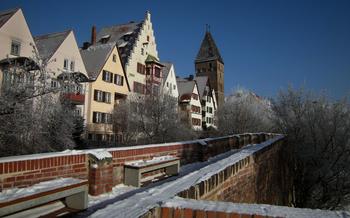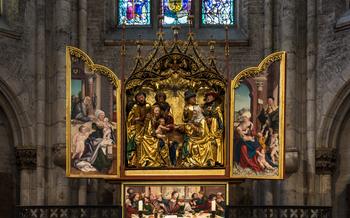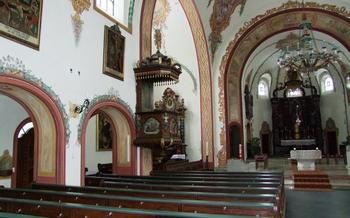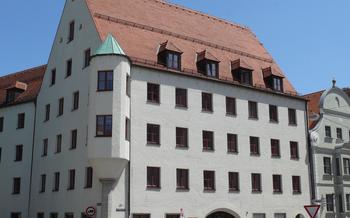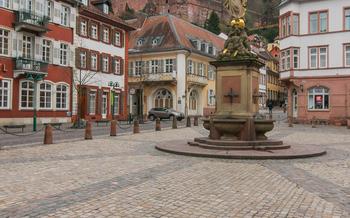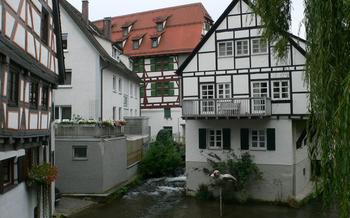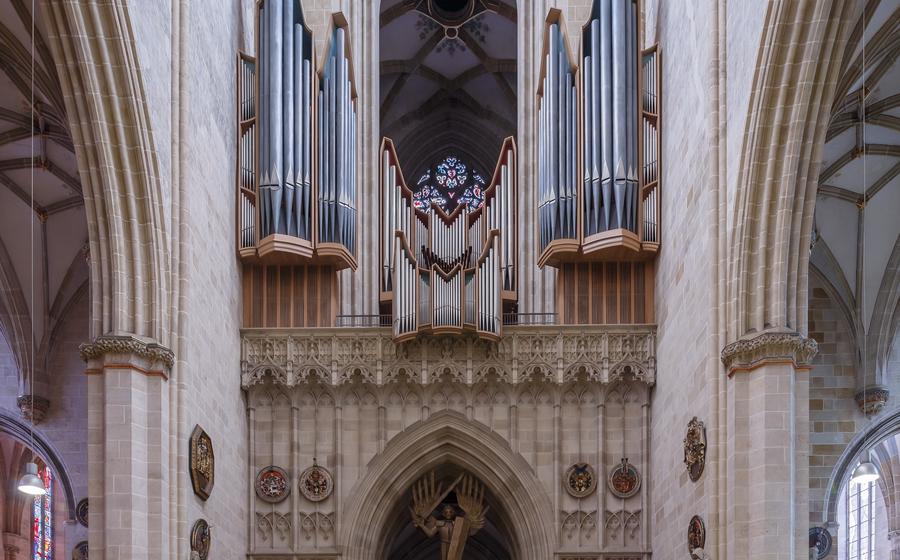
Danube River Promenade
- Ulm's Danube River Promenade: A Scenic Stroll Along the Water's Edge
- The Fisherman's Quarter: A Charming Historical District
- Ulm Minster: A Stunning Gothic Masterpiece
- The Town Hall: A Renaissance Gem in the City Center
- The Ulm Museum: A Journey Through History and Art
- The Wiblingen Abbey: A Baroque Masterpiece
- The Blautopf: A Natural Wonder with a Mystical Legend
- The Ulm Zoo: A Family-Friendly Adventure
- The Einstein Monument: Honoring a Genius
- The Museum of Bread Culture: A Unique Culinary Experience
- The Ulm Boat Tours: Exploring the Danube River
- The Christmas Market in Ulm: A Festive Tradition
- The Swabian Alb Biosphere Reserve: A Natural Paradise at Ulm's Doorstep
Ulm's Danube River Promenade: A Scenic Stroll Along the Water's Edge
Ulm's Danube River Promenade is a picturesque walkway that offers a delightful stroll along the banks of the majestic Danube River. Steeped in history, the promenade dates back to the 19th century when it was built to connect the city center with the riverfront. Today, it serves as a vibrant public space, attracting locals and visitors alike.
As you amble along the promenade, you'll be greeted by panoramic vistas of the city skyline and the meandering river. The cityscape is dominated by the towering Ulm Minster, its Gothic spires reaching towards the heavens. On the opposite bank, the Fishermen's Quarter, with its charming half-timbered houses, adds a touch of old-world charm to the scene.
The promenade is a hive of activity, with street performers entertaining the crowds and lively events taking place throughout the year. From concerts and festivals to markets and exhibitions, there's always something to experience. The promenade is also a popular spot for joggers, cyclists, and families with strollers, thanks to its smooth, accessible path. Wheelchair users can also enjoy a leisurely stroll, as the promenade is fully wheelchair-accessible.
The Fisherman's Quarter: A Charming Historical District
Step into the Fisherman's Quarter, a picturesque neighborhood nestled along the banks of the Danube River, and be transported back in time. Admire the rows of traditional half-timbered houses, each adorned with intricate details and colorful facades. Stroll along the cobblestone streets, where the sound of the river's gentle current fills the air.
The Fisherman's Quarter exudes a vibrant atmosphere, with cafes, restaurants, and shops lining the streets. Savor delicious Swabian cuisine at one of the charming restaurants, or indulge in a sweet treat at a traditional bakery. Browse through the unique boutiques and galleries, where you can find handmade souvenirs and local crafts.
From the quarter, you can easily access the riverfront promenade and embark on a leisurely boat tour. Glide along the tranquil waters, passing under ancient bridges and admiring the stunning views of Ulm's landmarks. Discover the rich history of the city as your guide narrates tales of the fishermen who once called this quarter home.
Don't miss the Fishermen's Church, a historic landmark that stands as a testament to the quarter's past. Step inside to admire its intricate stained glass windows and marvel at the stories they depict. The church is a symbol of the community's deep-rooted faith and a reminder of the quarter's humble beginnings.
As the sun sets, the Fisherman's Quarter transforms into a magical place. The soft glow of the streetlamps illuminates the cobblestone streets, casting long shadows that dance across the half-timbered houses. Enjoy a romantic dinner at a riverside restaurant, where you can savor the flavors of Swabian cuisine while admiring the twinkling lights of the city reflected in the water.
Whether you're seeking a glimpse into Ulm's rich history, a delightful culinary experience, or simply a tranquil stroll along the river, the Fisherman's Quarter has something to offer every visitor.
Ulm Minster: A Stunning Gothic Masterpiece
Ulm Minster, towering over the city skyline, is a testament to the architectural prowess of the Gothic era and a symbol of Ulm's rich religious history. As the largest Protestant church in Germany, it exudes an aura of grandeur and awe-inspiring beauty.
The intricate details of its facade, adorned with delicate tracery and sculptures, invite visitors to marvel at the craftsmanship of its builders. Inside, the soaring vaults, intricate stained glass windows, and elaborate carvings create a sense of reverence and wonder.
Climb the 768 steps to the observation deck atop the steeple, and you'll be rewarded with breathtaking panoramic views of Ulm, the Danube River, and the Swabian Alb. The city's landmarks, including the Town Hall and the Wiblingen Abbey, can be seen from this vantage point, offering a unique perspective on Ulm's cityscape.
Ulm Minster is not just a architectural masterpiece, but also a significant site in the history of the Reformation. It was here that Martin Luther's ideas gained a foothold in southern Germany, and the church played a crucial role in shaping the religious landscape of the region.
Guided tours are available to explore the interior of the minster, providing insights into its history, architecture, and religious significance. Visitors can learn about the symbolism behind the stained glass windows, the intricate carvings on the choir stalls, and the astronomical clock that adorns the nave.
Whether you're interested in architecture, history, or religion, Ulm Minster is a must-visit destination that offers a truly immersive experience.
The Town Hall: A Renaissance Gem in the City Center
Ulm's Town Hall is a magnificent example of Renaissance architecture, standing proudly in the heart of the city. Its intricate carvings, delicate frescoes, and ornate gables showcase the skill and artistry of the era. Built between 1433 and 1482, the Town Hall has served as the seat of local government for centuries, witnessing countless historical events.
The facade of the Town Hall is a masterpiece of stonework, adorned with intricate carvings depicting biblical scenes, mythical creatures, and historical figures. The large central window is framed by delicate tracery and topped by a triangular pediment featuring a sculpture of the Virgin Mary. The richly decorated oriel window on the upper floor adds to the building's grandeur, showcasing the wealth and power of the city during the Renaissance period.
Inside, the Town Hall boasts a grand staircase, a series of elegant halls, and a magnificent council chamber. The staircase, with its intricate wrought-iron railings and stone carvings, leads to the upper floors, where visitors can admire the impressive collection of portraits of former mayors and city officials. The council chamber, adorned with elaborate wood paneling and stained glass windows, is where important decisions affecting the city's fate were made.
One of the highlights of the Town Hall is its astronomical clock, a marvel of medieval engineering. Built in the 16th century, the clock features moving figures representing the seven electors of the Holy Roman Empire, as well as a celestial globe showing the positions of the sun, moon, and planets. Every day at noon, the clock comes alive with a delightful chimes show, attracting crowds of visitors who gather to witness this spectacle.
Guided tours of the Town Hall are available, allowing visitors to explore the building's interior, learn about its history, and admire the stunning artwork that adorns its walls and ceilings. The Town Hall is a must-visit for anyone interested in history, architecture, and the cultural heritage of Ulm.
The Ulm Museum: A Journey Through History and Art
Ulm Museum is a treasure trove of art, artifacts, and historical exhibits, inviting visitors on a captivating journey through Ulm's rich past and vibrant cultural heritage. With a diverse collection that spans various eras and disciplines, the museum offers a comprehensive exploration of the region's history, from prehistoric times to the present day.
Interactive displays and hands-on activities make learning fun and engaging for visitors of all ages, especially children. The museum's focus on regional history, including the Swabian era, provides a deeper understanding of Ulm's unique identity and its contributions to German culture. Temporary exhibitions showcasing contemporary artists bring a fresh perspective to the museum's offerings, ensuring a dynamic and ever-changing experience.
Whether you're an art enthusiast, a history buff, or simply curious to discover Ulm's cultural roots, the Ulm Museum is a must-visit destination. Its vast collection, interactive exhibits, and educational programs promise an enriching and memorable experience for every visitor.
The Wiblingen Abbey: A Baroque Masterpiece
Amidst the serene landscapes of Ulm, Germany, stands the magnificent Wiblingen Abbey, a testament to Baroque artistry and religious devotion. Built between 1714 and 1781, this architectural marvel boasts intricate stucco work, elegant frescoes, and a harmonious blend of styles. The abbey's church, with its soaring dome and radiant interior, is a masterpiece in itself. Step inside to admire the elaborate altars, delicate sculptures, and stunning stained glass windows that bathe the space in ethereal light.
The abbey's former monastery complex, with its cloisters, library, and grand refectory, offers a glimpse into the daily lives of the Benedictine monks who once called this place home. The Wiblingen Museum, housed within the abbey, showcases a rich collection of religious art, artifacts, and historical exhibits, providing insights into the abbey's history and significance.
Guided tours are available to delve deeper into the abbey's fascinating story. Learn about the skilled craftsmen and artists who contributed to its creation, the challenges they faced, and the enduring legacy of Wiblingen Abbey. Whether you're a history buff, an art enthusiast, or simply seeking a tranquil retreat, this Baroque masterpiece is a must-visit destination in Ulm.
The Blautopf: A Natural Wonder with a Mystical Legend
Among the natural wonders surrounding Ulm, the Blautopf stands out as a true gem. This deep blue spring, with its crystal-clear water, is a sight to behold. Surrounded by lush greenery and hiking trails, it invites visitors to explore its mystical allure.
Legend has it that the Blautopf is home to a water nixie, a mythical creature who grants wishes to those who dare to ask. The shimmering blue waters are said to be her domain, and visitors often toss coins into the spring, hoping to catch her attention and secure her favor.
For those seeking a refreshing dip, the Blautopf offers a unique swimming experience. The water is crystal clear and cool, providing a welcome respite on hot summer days. Visitors can also rent rowboats and paddle around the spring, enjoying the tranquility of the surroundings.
The Blautopf is not just a natural wonder; it also holds historical significance. In the 19th century, the spring was a popular destination for artists and poets, who were drawn to its beauty and mystery. Today, it continues to inspire visitors from all over the world, who come to marvel at its natural splendor and immerse themselves in its enchanting legend.
The Ulm Zoo: A Family-Friendly Adventure
Nestled amidst the serene landscapes of Ulm, the Ulm Zoo offers a captivating experience for visitors of all ages. Home to over 1,200 animals from around the world, the zoo is dedicated to providing a stimulating and educational environment for both animals and visitors.
Explore the diverse habitats and encounter majestic creatures, from playful monkeys and roaring lions to graceful giraffes and colorful parrots. The zoo's commitment to animal welfare is evident in its spacious enclosures, designed to mimic the animals' natural environments and promote their well-being.
Families will delight in the interactive exhibits and educational programs that bring the animal kingdom to life. Learn about the fascinating behaviors and adaptations of different species, and participate in hands-on activities that foster a deeper appreciation for the natural world.
The zoo's commitment to conservation and sustainability shines through its ongoing efforts to protect endangered species and promote responsible practices. Visitors can contribute to these initiatives by supporting the zoo's conservation projects and choosing sustainable options throughout their visit.
Plan a memorable day at the Ulm Zoo, where animal encounters, education, and conservation come together to create an unforgettable experience for the whole family.
The Einstein Monument: Honoring a Genius
In the heart of Ulm, nestled in front of the majestic Ulm Minster, stands a unique and thought-provoking tribute to one of the most brilliant minds in history - Albert Einstein. Born in Ulm in 1879, Einstein revolutionized our understanding of the universe with his groundbreaking theories of relativity and left an indelible mark on the world of science.
The Einstein Monument, crafted by the renowned sculptor Jürgen Goertz, is a striking bronze sculpture that captures the essence of Einstein's genius and his profound impact on our understanding of the cosmos. Unveiled in 1979 to mark the 100th anniversary of Einstein's birth, the monument portrays the physicist in a contemplative pose, his gaze directed upwards, symbolizing his insatiable quest for knowledge and his groundbreaking insights into the mysteries of the universe.
The monument is a testament to Ulm's rich scientific and intellectual heritage and serves as a reminder of the transformative power of human curiosity and the pursuit of knowledge. It invites visitors to reflect on Einstein's legacy and the enduring impact of his theories, which continue to shape our understanding of the universe and inspire generations of scientists and thinkers.
The Museum of Bread Culture: A Unique Culinary Experience
Ulm's Museum of Bread Culture is a one-of-a-kind attraction that celebrates the history, culture, and significance of bread. Housed in a former bakery, the museum offers an immersive experience that takes visitors on a journey through the world of bread.
With interactive exhibits, hands-on workshops, and a vast collection of bread-related artifacts, the museum provides a comprehensive look at the role bread has played in human civilization. Visitors can learn about the different types of bread, the process of baking, and the cultural significance of bread in various societies.
The museum's workshops offer a unique opportunity to get hands-on experience in baking bread. Under the guidance of skilled bakers, visitors can learn the art of bread-making, from mixing and kneading the dough to shaping and baking the bread.
The museum's extensive collection of bread-related artifacts includes antique baking tools, ovens, and a variety of bread from around the world. This collection provides a glimpse into the history of bread-making and the different techniques used in different cultures.
A visit to the Museum of Bread Culture is a must for anyone interested in food, history, or culture. It offers a unique and interactive experience that will leave visitors with a newfound appreciation for the humble loaf of bread.
The Ulm Boat Tours: Exploring the Danube River
Ulm's boat tours offer a unique perspective on the city and its surroundings, allowing visitors to explore the Danube River from a different vantage point.
Whether you opt for a short sightseeing cruise or a longer excursion, you'll be treated to panoramic views of Ulm's landmarks, including the majestic Ulm Minster, the historic Fishermen's Quarter, and the modern buildings along the riverbanks.
During the tour, you'll learn about the history and ecology of the Danube River, one of Europe's most important waterways. Discover how the river has shaped the region's landscape and culture over centuries.
Some boat tours also offer themed cruises, such as sunset cruises, dinner cruises, and even wine tasting cruises. These special cruises provide a unique and memorable experience, allowing you to enjoy the beauty of the river while indulging in local culinary delights.
Insider tip: For a truly unforgettable experience, book a private boat tour and customize your itinerary. This allows you to explore hidden gems along the river, such as secluded coves, nature reserves, and charming villages.
The Christmas Market in Ulm: A Festive Tradition
Ulm's Christmas market, one of Germany's oldest and most enchanting, is a must-visit during the holiday season. With over 100 festively decorated stalls lining the streets of the city center, the market exudes a magical atmosphere that transports visitors to a winter wonderland.
The air is filled with the scent of gingerbread, roasted almonds, and mulled wine, as vendors offer a tempting array of handmade crafts, decorations, and culinary delights. From intricate glass ornaments to traditional wooden toys, there's something for everyone to treasure.
Immerse yourself in the festive spirit as you wander through the market, admiring the twinkling lights and listening to live music, choirs, and caroling. Take a break from shopping to warm up with a mug of Glühwein (mulled wine) or Kinderpunsch (mulled fruit juice for children) and savor the festive atmosphere.
The Christmas market is also a great opportunity to explore Ulm's historic city center. With its charming half-timbered houses and Gothic architecture, the city provides a picturesque backdrop for this enchanting holiday tradition.
Insider Tip: To fully experience the magic of Ulm's Christmas market, visit on a weekday evening when it's less crowded. This will allow you to soak in the festive ambiance and enjoy the sights and sounds of the market without the hustle and bustle.
The Swabian Alb Biosphere Reserve: A Natural Paradise at Ulm's Doorstep
Just a short distance from the bustling city of Ulm lies the Swabian Alb Biosphere Reserve, a UNESCO-designated natural paradise that offers a tranquil escape into a world of diverse landscapes and rich biodiversity. Whether you're an avid hiker, a passionate cyclist, or simply seeking a serene retreat, the biosphere reserve has something to offer everyone.
Lace up your hiking boots and embark on a journey through enchanting forests, scale rugged cliffs, and meander along babbling brooks. The biosphere reserve's extensive network of trails caters to hikers of all levels, promising breathtaking panoramic views and encounters with the region's unique flora and fauna.
For those who prefer two wheels, the biosphere reserve is a cycling haven, with designated bike paths winding through picturesque villages, past shimmering lakes, and amidst rolling hills. Experience the exhilaration of pedaling through pristine nature, surrounded by the sweet chirping of birds and the gentle rustling of leaves.
In the winter months, the biosphere reserve transforms into a cross-country skier's paradise. Glide effortlessly across snow-covered meadows, inhaling the crisp, invigorating air and marveling at the winter wonderland that unfolds before you.
Beyond its natural beauty, the Swabian Alb Biosphere Reserve is also home to a rich cultural heritage. Discover charming villages nestled amidst the rolling hills, each with its own unique history and traditions. Explore ancient castles that stand as silent witnesses to bygone eras, their walls whispering tales of chivalry and intrigue.
As you wander through the biosphere reserve, keep an eye out for the region's diverse wildlife. Spot graceful deer grazing in the meadows, wild boar foraging in the forests, and rare bird species soaring overhead. The biosphere reserve is a haven for nature lovers, providing a sanctuary for countless creatures, both big and small.
Whether you seek adventure, tranquility, or a glimpse into the region's rich cultural heritage, the Swabian Alb Biosphere Reserve offers an unforgettable experience that will leave you feeling refreshed, inspired, and deeply connected to the natural world.
